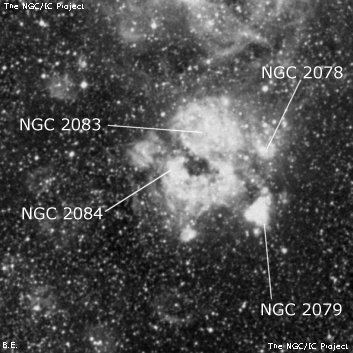
John Herschel discovered NGC 2084 = h2953 in Dec 1834 and described as "The south following nucleus of the complex group of Plate III fig 4, from drawing." Herschel's sketch shows 7 condensations or nuclei, involved in nebulosity. The four NGC objects in this grouping are NGC 2078, 2079, 2083 and NGC 2084. The complex was discovered earlier by James Dunlop on 24 Sep 1826 and D 149 was recorded as "a faint round nebula, about 1' diameter". His description could apply to NGC 2084 or one of the others in the nebulous group. His position was ~5' too far east.
600/800mm - 24" (4/10/08 - Magellan Observatory, Australia): This emission knot was noted while making a careful observation of NGC 2084, which is located within the southeast region of a very bright nebular complex NGC 2078-79-83-8 (LMC-N159), located ~40' SSE of the Tarantula Nebula. At the northeast end of the NGC 2084 region I noted a moderately bright, round knot, ~45" diameter. Without a filter a star is involved with this glow. Although John Herschel didn't catalogued this knot, it's shown on his sketch (Plate III, figure 4). NGC 2084, a brighter knot, is close WSW on a direct line with NGC 2079. NGC 2084 appeared very bright, fairly large, elongated, ~1.2'x1.0'. Removing the filter a couple of stars are involved (with one brighter star).
24" (4/10/08 - Magellan Observatory, Australia): I returned to this detailed nebula the following night to make a complete observation at 200x using a UHC filter. NGC 2084 forms the SE region of the complex and it's composed of several nearby components. At the NE end of this extended region is a moderately bright, round knot, ~45" diameter (N159G). Without a filter a star is involved with N159G (sketched by John Herschel but not catalogued). A second, brighter embedded "glow" is close WSW on a direct line with NGC 2079. This knot corresponds with John Herschel's position for NGC 2084 and is catalogued as N159C-east. It appeared very bright, fairly large, elongated, ~1.2'x1.0'. Removing the filter a couple of stars are involved (with one brighter star). Finally, N159C-west (also sketched by Herschel but not cataloged) lies 1.5' W of N159C-east in the center of the entire complex and is connected to N159C-west by a faint bridge of nebulosity. N159C-west appeared fairly bright, moderately large, round, 45" diameter.
24" (4/9/08 - Magellan Observatory, Australia): this is the SE component of a fascinating 4' HII complex filled with up to 8 distinguishable knots (4 have NGC numbers) with several of the brighter knots forming an "S" shape (this knot is at SE end of the "S"). At 200x and UHC filter it appeared very bright, round, fairly large glow, 1' diameter and encased within fainter nebulous haze that extends to the west. NGC 2083 lies 1.5' NNW within the background glow that envelopes the entire complex.
Notes by Steve Gottlieb